 The best way for juniors to learn new skills is to have them perform golf practice drills that are fun and challenging for them to do to improve. Anybody involved in junior sport knows that children love to be involved and take part in "games" that are not necessarily competitive, but give the child a sense of accomplishment when they can complete the drill or exercise. The drills that are easy to set up and use along with practical training aids that are easy to bring along with you to the driving range or golf course are the best. These drills are designed mostly around the short game so they can be done by juniors from the age of 7 years and older, as physical strength is not a prerequisite. But remember that good fundamental technique is required to complete the drills.  Putting (Speed Control Drill) Most juniors starting out have not developed speed control so the earlier you can introduce the importance of "speed being the king" and the line of the putt coming second the better. Place two tee's into the green 3 feet apart and another two tee's 3 feet behind them. Take two clubs preferably wedges and place the grips on the front tee's and the club heads on the back tee's as pictured (left). This forms a suspended target and you can finish it off by placing an alignment stick at the back end. Take 10 balls and starting from a 3 feet distance out, place a ball at 3 feet intervals (3, 6, 9, 12, 15, 18, 21, 24, 27, 30). The objective of this drill is to putt as many of the ten balls into the 3 feet square target. Keep a record of the best result so there's always a record to beat the next time the drill is done. Pick a flat part of the putting green to start with and move on to breaking putts after the junior is averaging more than 70% consistently on the flat putts. 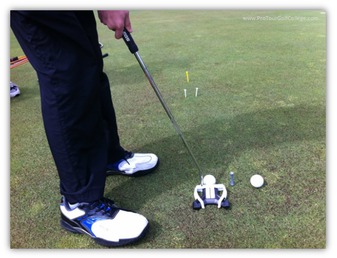 Putting (Speed and Line Drill) Find a flat spot on the putting green, place a ball on the green and two tee's each side of the ball slightly wider than the ball. Place another tee a putter grip length behind the two tee's. To finish the set up use the length of putter to measure and place another tee as the starting point of the drill as in picture. Now using two golf balls start at the putter length tee and the objective is to putt two balls in a row through the tee's and stop the ball before the grip length tee at the back. Once the junior has achieved this, move the putter length tee to two putter lengths away and repeat the drill. Set a time limit of 15 minutes and see how many putter lengths the junior finishes from the target.  Chipping (Contact and Landing Spot Drill) When a junior can learn to contact a chip correctly it will also help to improve their contact with the full iron shots as well. So they are never too young to learn how to achieve good impact conditions. For this drill two alignment sticks are required. First place an alignment stick 4 inches behind the ball with the second stick on the green where you want the ball to land as pictured. The first objective is to not hit the stick behind the ball which will encourage a slightly descending strike. The second objective is to land the ball just before the stick on the green and "leap frog" it, allowing the ball to run out to the hole. Adjust the stick on the green if it's not in the right position, and change the loft of club if needed. This drill teaches solid contact and gives good visual feed back on the trajectory and roll of the ball with different clubs.  Pitching (Edge of Green Drill) For this drill place an alignment stick 6 feet onto the green. Measure and place markers at 10,15, 20 and 25 yards with the objective to hit 5 shots from each distance for a total of 20 shots and measure how many of your shots hit the green in the zone. This drill helps you to develop good distance control from the different distances which is crucial as most juniors at this stage don't hit greens in regulation and so building a solid scrambling game will be an advantage.  Bunker (Trench Drill) This is such a simple yet effective drill to teach juniors, or in fact any golfer how to make good contact on a basic bunker shot. Place a ball in the bunker and dig a trench behind the ball with your club head. Next remove the ball and get the junior to set up with the trench opposite the center of their stance and ask them to strike the target side of the trench as shown in the picture and blast the sand outside the bunker. It is important that the sand to the right of the trench is not touched when doing this drill. When the junior can displace the sand on the target side of the trench 7 out of 10 times place a ball just left of the trench. Now repeating the same swing striking the target side of the trench with the goal of making the sand land outside the bunker which will see the ball fly softly out and onto the green. These are just a few of the drills that you can introduce to your child, or the junior that you are coaching. It is helpful to remember to allow them to learn the skills themselves. Show them how, and then let them learn their way. Be reminded that the more you can create a fun learning environment - rather than a teaching environment, the quicker they will learn the new skills and have fun whilst they do it. David Milne and Lawrie Montague - Pro Tour Golf College Your Success On Tour is Our Business "It’s a whole lot of moving parts that make up the whole, and your job is to learn, coordinate and synchronize those parts to work in harmony with one another to create a successful collision with a golf ball, that sends the ball on its way towards your target, many times over".  One of the biggest challenges you face as a an advanced or elite level golfer is to keep improving, and the most pressing issue you will face will be “staying the course,” or in other words, to keep pushing forwards when all you seem to experience each time you practice is set-back and a lack of progress. Now’s there’s nothing more frustrating than to practice golf drills or skills and not see the improvement that you expect. You are putting the hours in and you expect improvement, but when you go out to play and test it, you find that it hasn't improved. You can have the best self-talk skills in the world but that means nothing if you haven’t learned the golf skill or drill well enough to trust it. You see every time you play golf you are simply executing a whole range of specific behaviors that when put together over 9 or 18 holes amounts to your performance. The trouble is that it’s one thing to practice with the intention of improving a golf skill, and another to realize that your idea of when you should improve a part of a golf skill, and that of your nervous system is probably miles apart. Learning is remembering, and then ultimately memorizing, which is often described as the unconscious competence or autonomous stage of learning. It’s the “forget you know how to” stage of learning. Can you achieve an unconscious competence level with a flawed golf swing technique? You bet you can. You can master flawed techniques as easily as correct ones. So it’s important to learn golf skills carefully with accurate feedback from well designed practice drills and the most relevant training aids that ideally are recommended to you by your golf instructor or coach. This is so you can recall the movement patterns correctly and accurately every time you go to practice. All things being equal - the more practice (repetitions) of the drill or technique that you perform, the more learning that should result from it. Keep in mind though, that the more complex the drill you are performing (the more moving parts to coordinate), the longer it will take to integrate into your golf stroke pattern. For example, a slight grip change could be considered a low complexity change, and your new grip routine might take you 4 weeks or longer to integrate into your technique with daily repetitions performed correctly. A downswing drill on the other hand where you might be moving your right elbow more in-front of your right hip in the delivery position (higher complexity) might take a lot longer to integrate, and will require a lot more repetitions. One of our tour players we consult with has been working on a downswing to post-impact drill for more than 12 months and only recently is starting to trust the change when he competes in tournaments. The other thing to consider is that some parts of the whole technique will be more advanced along the learning pathway than others. As I mentioned, you have different parts that require more effort to integrate than other parts. Generally speaking, it is going to take more time than you think to improve all the parts that make up the whole. Think about it; what you are doing is practicing recall in the form of specific movement patterns or motion. That’s all a golf stroke is. It’s a whole lot of moving parts that make up the whole, and your job is to learn, coordinate and synchronize those parts to work in harmony with one another to create a successful collision with a golf ball, that sends the ball on its way towards your target, many times over. 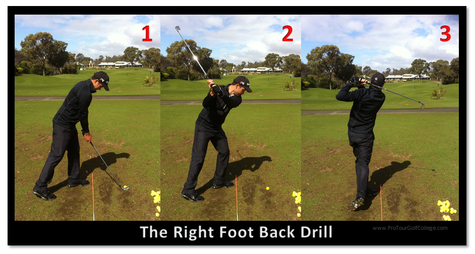 But how do you manage the learning of all the parts that make up the whole? Let’s say that you have been to see your golf instructor and she/he has given you a drill, or some drills to work on to improve your golf swing, and now you have to allocate time out of your week to practice the drill. What is the best way to do this? Well, the way we suggest you do it is with the use of a Golf Drill Accountability Log that will keep you on-track with your goal of turning your golf practice drills into peak performance skills. Learning = Correct Practice Drill + Repetitions x Time This accountability log will help you to manage the amount of drill work you are performing, whether it’s a full swing drill or a short game drill. When you fill out the log you record data on how many repetitions you performed per practice session, and also the quality of the practice session, which is based on a quality scale from 1 to 7. If you want the drill you are practicing to stick, then you need to make sure that every time your perform repetitions of the drill, that you put all your focus into performing it exactly as it was taught to you by your instructor.
For every set of 10 repetitions of the drill, rate your level of performance from 1 to 7, with 7 being the best it can be performed, and 1 being the worst it can performed. If you just perform your drills in a random and haphazard way then it would be difficult to expect progress because there’s no way to know whether the drill is actually moving you closer to integration. The use of practice drills and training aids form an integral part of the golf improvement learning process. By carefully managing your expectations, and realizing that you have to learn the information so you can perform it at the unconscious competence level you will stay the course and be able to turn it loose in tournaments with confidence. Remember it always takes longer to learn in the body than it does to learn in the mind. Are you up to the challenge? Lawrie Montague and David Milne - Pro Tour Golf College Your Success On Tour is Our Business Do you want to learn how to break 80, 75 or even 70? I bet you do, and today we are very excited to launch our new 12 Week golf practice improvement program, Hard Core - The Elite Golfer Improvement System (E.G.I.S) which has been designed to help you to get to those lower and difficult to reach score averages.  Why is it Called Hard Core? We named our program Hard Core - Elite Golfer Improvement System because when we were conceiving the idea of a golf practice improvement program we wanted to eliminate the golfers who just won't practice enough, and are not fully committed to lowering their golf scores. Golfers who are looking for a fast-track to golf improvement, which we've yet to find. Golf is a difficult game mostly because of the way golfers go about their practice, and your golf practice process significantly influences the way you play, so it just makes good sense for us to build a culture of hard core, motivated golfers who know how to practice, want to practice hard, and more importantly--want to keep getting better! Who Will Benefit from this Program? If you are the type of golfer who takes complete responsibility for your success and can be accountable to the E.G.I.S principles and process, then this program is the ideal program for you. It doesn't matter whether you are aged 17 to 70, as long as you can follow some simple procedures, you can learn how to improve your golf scores. Ideally you should work with your golf instructor/coach using the E.G.I.S program as your golf instructor can help you to improve your weakest-most important golf skills which is the cornerstone of this golf practice program. If you don't have a golf instructor work with the person who knows your game the best. The Need for a Golf Practice System for Good Golfers David and I have been inspired to bring this unique golf improvement program to you because we saw a great need for the type of information that our new program provides, and also because of your interest over the past 2 years in our "How to Practice Golf" approach to lowering your competitive score average. An Affordable Golf Score Improvement Program The other thing that is important to us is to share our extensive knowledge and experience helping advanced golfers to lower their golf scores with useful golf products that are priced reasonably. Yes we could charge a lot more for the information in our E.G.I.S program, but our primary goal is to price it so more advanced and motivated golfers like you can practice to improve. We Know That You Are Amazed That We Could Charge So Little For So Much! So What Are You Waiting For?... Just click the "Buy Now" button directly below and once you have checked out we will email your password to you (within 60 minutes) so you can gain access the E.G.I.S download page (at www.protourgolfcollege.com) where you can download the E.G.I.S Lesson Manual, the training templates and all the videos. Lawrie Montague and David Milne - Pro Tour Golf College 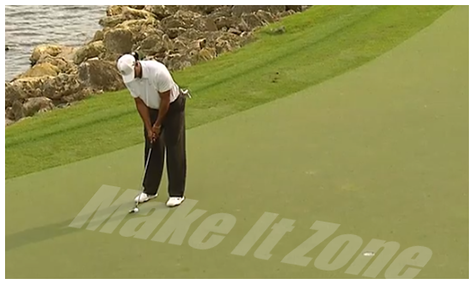 It's well and good to have good green-side skills like chipping, pitching and bunker shots, but if you can't convert the putt it will not help you to lower your competitive score average. An interesting statistic on the PGA Tour is that the top ten players proximity to the hole from bunkers year-in-and-year-out is between 6 feet to 7 feet. And the proximity to hole from inside 20 yards of the green for the top ten players on the PGA Tour is just 5 feet 6 inches. What does that tell you? Well even if you don't have a a short game like PGA professional Tiger Woods, it should tell you that you need to practice your putting skills from what we call "the make it zone," and simulate the type of pressure you're likely to experience when you play in golf tournaments. My co-director at Pro Tour Golf College Lawrie and I have just produced the following 19 minute video for you which will show you how you can do this. The Progressive Distance Intensity Putting Drill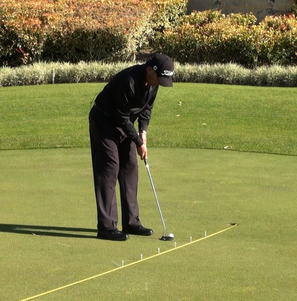 First find a straight putt and get a measuring tape and stretch it out to seven feet. Place tee's starting at 2 feet, 3 feet, 4 feet, 5 feet, 6 feet and 7 feet. Now the object of this drill is to use one ball and start at the tee at 2 feet. After sinking that putt move back to the next tee until you make all 6 in a row. So what's so hard about that you might ask? Well the pressure is activated when as soon as you miss from any distance along the 6 distance points you have to go back to the 1st tee and start the drill again. The idea is that the pressure builds up as you move back down the line. It's not a race, so go through your normal pre-shot routine for each putt. Put a time limit of a maximum of 30 minutes to complete this intensity drill. You can extend this drill to practice breaking putts (left to right and right to left) from the same distance as outlined in the video with two additions to the set up. Place a tee on the low side of the hole that covers a quarter of the hole (right edge if it's a left to right putt as in the video) and another tee 18 inches behind the hole. The key to excelling with breaking putts (especially when the greens are fast) is to always pick the speed first and the line second. Picking a speed that will allow your putt to finish inside the tee which is placed 18 inches behind the hole if it misses should be your first priority.  Once you have decided on the speed pick the line that will bring the ball from the high side of the hole (left side for a left to right putt) which effectively makes the center of the hole more to the left compared to a straight putt. You can visualize a clock face (as Lawrie's doing here) and you want the ball to enter the hole at 7, 8,or 9 o'clock. The faster the speed of putt the higher the entry point into the hole. The key to putting under pressure is to practice with the right attitude. Make sure you understand if the drill you are doing is a technique or targeting drill? Technical Practice and Targeting Practice The difference is when you are doing a technique drill the focus is on improving your stroke mechanics and getting a feel of the new stroke pattern compared to the old stroke pattern. You don't even require a hole, and you may use a training aid or machine that will give you the proper feedback through feel. When you are doing a targeting drill there should be no technical thoughts. You have to match the 'feels' required to putt the ball at the correct speed and on the selected line into the hole. So less feel about the stroke and how it looks and more about the feel in your hands-arms and shoulders for making the putt. This is especially important on breaking putts when you're taking practice strokes with the eyes following the curve of the intended putt, and also internalizing the speed of the ball as it enters the hole from the high side.  The Tiger Woods Short Putt Drill An excellent drill to acquire feel in you're putting stroke is one that Tiger Woods uses at every tournament and has used for many years. He addressees the ball with his putter and places two tees either side of the toe and heel with just enough room for the putter to stroke the ball and not hit the tee's. He then places only his right hand on the grip and the left hand in his pocket and strokes the ball between the tees. He normally does this drill from 4 to 6 feet. He says that this putting drill helps him achieve good feel and tempo for the speed of the greens that particular week. Now if you are a more left sided feel person then do the opposite to Tiger and place you're left hand on the grip with the right hand in your pocket. This drill promotes good tempo and a solid strike which encourages excellent distance control on all putts. Lawrie and I know these pressure putting drills and pressure putting attitude will help you sink more putts if you apply the information the right way. If you enjoy our regular articles on advanced and elite golfer development please tell you friends and share our blogs on facebook and Twitter. Make sure you check out our new program The Elite Golfer Improvement System which is a 12 Week online golf improvement program for advanced golfers being launched this Saturday at 12:00 pm Perth, Western Australia time. For readers of our blog and supporters of our programs we've got a special limited time launch price for access to our new program, which you can find out about tomorrow. David Milne and Lawrie Montague - Pro Tour Golf College Your Success On Tour is Our Business  In recent times (over the last 15 years) there has been a huge leap forward in equipment that is available for junior golfers taking up the game at the entry level, and it's getting better. From clubs, bags, pull trolleys, shoes, gloves, caps and attire identical to the leading young "superstars" the junior golfer can "look the part". There are also the choice of right or left handed clubs, and more importantly, the weight, lie angle, grip size and length are suitable for juniors from five years old to around 11 years old. I believe that this better fitted equipment has been one of the main contributors to why there are so many more young golfers that are able to compete at a very high level sooner. It wasn't too long ago when a youngster taking up the game was confronted with the popular option of cutting down Dad's or Mum's old set of clubs to start off! The shafts by cutting and shortening them would effectively make them stiffer.  The lie angle (the way the club head sits on the ground at address and impact) would be too upright (toe up off the ground) for the junior, and combined with the stiffer shafts would encourage two things. First, the stiff shafts would help produce a low dipping ball flight causing the junior to hang back onto their right side (right handed) to try and help the ball to fly higher. Secondly, the upright lie angle will encourage a pull and/or hook even when the junior makes a good swing! Plus the heel of the club will contact the ground first and twist the club-face closed. An example in the picture opposite of two clubs that were identical until our master club-fitter / club maker Greg Ashton put the bottom club on a grinder and cambered the heel down. This has allowed two things to happen that will definitely suit a junior golfer. It will make the club lie angle easier to adjust, and more importantly it will take 20 grams of weight off, which makes the golf club a lot more suitable. The only way the junior can make the ball go straighter (when the shaft is too stiff and lie angle is too upright) is to grip the club with their hands turned to the right (right handed) until the right hand is positioned nearly under the grip, and the left hand is showing all the knuckles, which is considered a "strong grip," to try and stop the club face from closing. You're now getting the picture that these two conditions in a very short span of time can sabotage good dynamic balance, and encourage a weak blocking action. And once these two patterns have been grooved they are extremely difficult to change. 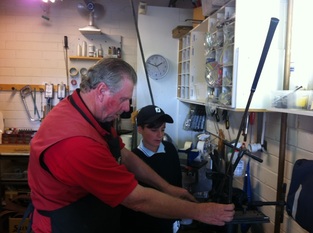 Master club-fitter / builder Greg Ashton working on a junior club Master club-fitter / builder Greg Ashton working on a junior club As I mentioned at the start, entry level equipment is better but there is a "gap" when the junior reaches around the age of 10 to 11 years of age. This is the age that girls in particular start to go through a growth spurt but are still not ready for adult clubs. In the recent 2013 US Women's Amateur ten year old Lucy Li competed and shot a 70 in the 2nd round. I can assure you she was not using junior or adult clubs. This is where a specialist club fitter/club maker is needed to build individually fitted clubs/sets that will encourage the junior to keep improving performance, leading to lower scores. When juniors at this stage start to increase their club head speed the entry level shafts are not suitable anymore. Mainly because they are too whippy, unstable and cause inconsistent contact and direction. The club fitter can identify the right length, weight and shaft frequency to suit the junior golfer and most importantly check the clubs at set intervals to make sure that they stay that way. If you are serious about your child's ongoing development through this cycle and beyond, you need to find a club fitter/club maker that you and your child can build a relationship with. Ask the professional that coaches your child for his/her recommendation, or even parents of other juniors that may use someone that they can refer you on to. All major manufacturers have junior golf sets in their range, but what I am saying is at some point your child will need to be individually fitted by a specialist who can build a set of golf clubs that will allow your child to achieve their full potential. In my view off the shelf clubs are great for juniors starting off, but from the age of eleven on-wards align yourself with a professional and/or clubfitter that will advise and guide you towards equipment that will enhance the ongoing development of your child. At Pro Tour Golf College we have master club fitter Greg Ashton to look after all our students equipment needs as we know that this is an essential part of the development pathway for all of our students. David Milne and Lawrie Montague - Pro Tour Golf College Your Success On Tour is Our Business "If you are a serious golfer who practices a lot and isn't satisfied with your level of progress then you need to do something about it!" 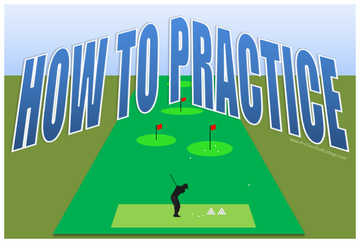 We write a lot about the process behind improving your golf scores because after all, isn't that what golf is all about - finding ways to lower your golf scores so you can become more competitive in the tournaments you play in? The Japanese word Kaizen loosely translated means “change for the better” or “improvement,” and it is the goal of constant and never-ending improvement that should be your goal as an advanced or elite level golfer. It is interesting to note however that this is not as easy to do and it sounds like because our observation (over many years) of advanced golfers going about their golf practice suggests that the vast majority don't know how to practice to improve. We think that a big part of the problem is the emphasis in golf of being focused too much on "what to practice" and not enough on how to practice. In fact we honestly believe that this is the next big thing in golf--learning how to practice properly to improve. Why? The simple reason is that more advanced and elite level junior and college golfers want to become professional golfers at a younger age because the financial rewards of being successful in golf are too good to ignore.  Take Jordan Spieth for example. I wrote recently about Jordan as a young golfer with the potential to become one of the best players in golf, and within a couple of weeks of publishing our article he won a tournament on the PGA Tour before his 20th birthday in spectacular style by holing a difficult bunker shot on the last hole. In this article I’ll explain a concept that will help you to decide on the skills that you should work on that will lead to consistent change. But first you need to understand that there are golf skills that can have a big impact on your game, and others that lead to marginal, if any improvement. There is a mental shift you need to make to generate consistent change. You need to focus more on continually determining which of your golf skills needs attention for you to make consistent progress with your game. But how do you do this? How do you know what to practice to improve? Before you learn how to practice you first need to decide which golf skills need work and which skills need less. When you play your round it is made up of various golf skills that help you get from the tee to the green. If for example you have a scoring average of 76 (+ 4) around your golf course, we could look at the skills that had a major impact on your score average and decide upon a strategy that could help to lower that score average. So let’s have a quick look at our new and comprehensive golf practice improvement system Elite Golfer Improvement System (E.G.I.S) for lowering your golf score average. Imagine if you had a range of easy to fill out assessment templates that would help you to accurately assess your golf skills, and from there you could work out exactly which golf skills you need the work to lower your golf score average. They might look like these Golf Skill Assessment Templates.  Click on the image to make it larger Click on the image to make it larger From here you could transfer the data to template that would help you to determine which golf skills that hold higher value in your golf improvement than others. You could rank each golf skill based on a simple color rank that tells you exactly where you are compared to top level golfers. No more comparing yourself to others, you simply practice to push your golf skills from one color to the next, realizing that as you change color you are improving. 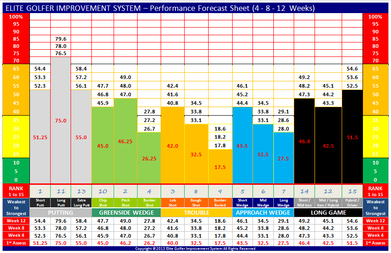 Click on the image to make it larger Click on the image to make it larger But that's not enough. To get better at golf you need goals along the way, and the very best way to develop your golf skills is to establish bench marks over a period of time to keep you focused, and at the same time to tell you where you are on your journey to improvement. You need to be able to forecast the improvement you are looking for, and you need a simple-straightforward way to do this. We have developed just such a template that will help you to stay right on track with your performance goals.  When you practice each week you will also need a weekly planner so you can work out when you will practice, and also what you will practice. And you will need a daily practice log sheet designed for you to stay focused on the golf skills that make the most difference to your golf scores.  Every week you finish that weeks practice you will want to know how you are travelling in relation to your goals, so you will need an easy to fill out template will help you to do this. Why go to all this trouble? Well, it's simple really. Why guess when you can test, measure, practice and improve. If you are a serious golfer who practices a lot and isn't satisfied with your level of progress then you need to do something about it! You need the most comprehensive golf practice improvement program ever developed for serious golfers of all ages. We have invested more than 300 hours putting this program together for you. So in next weeks blog we'll show you what the program is all about, and again we sincerely thank you for your patience in allowing us to bring the best golf improvement program of its kind to you, the serious and advanced level golfer.
Lawrie Montague and David Milne - Pro Tour Golf College Your Success On Tour is Our Business  In the past decade, “mental toughness” has become a hot topic among researchers, sport psychologists, and coaches alike. Prior to the influx of research on the subject much of what was known about mental toughness was based on anecdotal reports and disseminated predominantly through the popular media. The result was a diverse selection of definitions and explanations of mental toughness that largely included an assortment of beneficial psychological characteristics (e.g., self-confidence, insensitivity to criticism) and mental skills (e.g., arousal regulation, visualization). The conceptual confusion created from this lack of consistency and understanding resulted in numerous beneficial psychological characteristics being incorrectly labelled as mental toughness, particularly as they were based on authors’ opinions rather than empirical research. Everything from resilience to focus control appeared to capture mental toughness at one point or another. As a result, most athletes still do not know where to begin in their self-assessment of mental toughness, and most discussions I have around the topic with coaches still settle on the question, “what is mental toughness?” Encouragingly, the latest empirical research by Dr Daniel Gucciardi and colleagues on mental toughness has tightened the definition and condensed its defining attributes to just six priority factors. Mental toughness encapsulates an individual’s capacity to produce consistently high levels of performance or goal attainment despite everyday challenges and significant adversities. The six core components to have emerged across the available research and appear to capture the essence of the current state of affairs are as follows: Now that you are aware of the six core attributes of mental toughness, you can better direct your self-assessment. Before you begin profiling, first consider this common misconception about mental toughness. You Either Have It, Or You Don’t! (Not So!) The most prominent mistake most coaches and athletes make when profiling mental toughness is categorizing an athlete as either mentally tough, or not, with no in between! However, mental toughness is not an all or nothing concept. In fact, athletes demonstrate mental toughness qualities in varying degrees which can also fluctuate depending on an athlete’s life climate at certain points in time. You simply do not lose mental toughness or become mentally tough at one point in time. The best athletes demonstrate multiple attributes of mental toughness in strong apparent ways on and off the course. An assessment of the six core attributes of mental toughness in a player dominating the tour at a point in time, will likely demonstrate a strong expression of all six factors in their game. When players are not performing to their potential or seem to be in a slump, they show a regression of these qualities in action. You can see this regression in their actions on and off the course, the thoughts they express about their game, or in their approach to the game. In line with the view that mental toughness is NOT an all or nothing concept, Pro-Tour Golf College Directors David Milne and Lawrie Montague share some key examples of mental toughness in action on the tour: “For any player to achieve any kind of success at the very top level they have to possess the first four attributes (success mind-set, optimism, self-efficacy, and emotional control) no exceptions.”  “If we look at specific examples, a player like Tiger pre 2009 was the best in all categories and probably struggles with the attributes of attention regulation and knowledge.”  “Sergio Garcia is an interesting player who has all the elements but for some reason not all at the same time. Element three (Optimism) is an area that he struggles with at times.”  If we look at examples of top players that demonstrate a regression in the expression of the six key elements of mental toughness, In David’s view, Anthony Kim comes to mind. “Kim was a top ten player until 2010, but speculation of a party life style and multiple injuries have derailed is career.” When a player shows a strong success mind-set their pathway thinking or action plan for the future protects athletes from appealing diversions and discipline and focus remains high in the face of common distractions. Unsuspecting events like injury or illness can rock a player’s self-efficacy, mind-set, and general optimistic outlook on their career. Such experiences can act as “triggers” that lead to a decline in a player’s expression or use of certain mental toughness attributes, resulting in a drop in performance.  In an important closing reflection, David Milne says, “it is extremely unusual for a player to have all 6 elements of mental toughness all the time but most of the top players get them all lined up for short periods (4-6 weeks) and that’s when they are in contention each week which lead to their occasional wins. Henrik Stenson at the moment is in one of those periods.” Profiling my mental toughness attributes:
Get to know your triggers!
Like all elements of your game, even your mental toughness requires conditioning. You must work hard to build and maintain these qualities in action on and off the course. Dr Jay-Lee Longbottom For more detail on the latest mental toughness research by Dr Gucciardi and colleagues visit: www.danielgucciardi.com.au/  You can be assured that the answer is a big Yes! The main reason is that apart from the US Masters the other majors have a set rotation of courses that they use, so it could be a gap of ten years before a course gets to host the next major. During this period most golf courses make alterations to their course to try and keep up with the technology that threatens to make their courses obsolete. Apart from the obvious lengthening, redesigning or reshaping of greens, these are the type of defenses that courses present to make it more challenging for the competitors. With this in mind, competitors (and I believe the ones that have targeted majors as a priority) have qualified for the event well in advance, will leave no stone unturned in their preparation to win a major. Most of these professionals are ranked in the top 50 in the world golf, and their playing schedule is locked in for the year, so they can make multiple visits to the venues prior to the tournament, and spend countless hours getting to know the course and it's nuances. 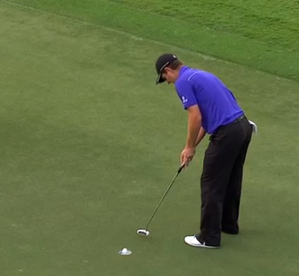 At this years US Open one of the professionals competing in the event brought his putting coach (David Orr) to Merion, and they spent countless hours on all quadrants of the 18 greens taking notes until they knew the movement, speed and where the grain of the grass grew. And he did the same with his swing coach (Sean Foley) to map the course, and develop a strategy to play Merion from the tee's, and also the best approach line to the green from the fairway. Yep the professional was Justin Rose, the eventual winner, and it is a testament that thorough preparation pays off! This is the type of preparation that the top pro's see as essential preparation if you wish to succeed at the highest level. You cannot do this during tournament week as it takes so much time, (approximately 8 hours) and you would be holding the field up an asked to move on. There are also rules on how many balls for each shot you may hit during practice rounds and officials are very strict and enforce the rules rigorously.  So tee shots and putting are the priority, but also testing out the sand in the bunkers, so that the appropriate technique can be applied for the best result. Testing and practicing shots around the green with different clubs to get a feel of the conditions should always be on your agenda.To fast track local knowledge, speak with the local golf professional (or his/her assistant) about local conditions is always a good idea. The great Ben Hogan was known to look back to the tee box from the green to get another perspective of how the hole looks. Try this out yourself the next time you're at a tournament venue preparing to play in the tournament and you will see things more clearly, and you will notice many things that you can't see from the tee box and the fairway. David Milne and Lawrie Montague - Pro Tour Golf College Your Success On Tour is Our Business "Like the medical field has general practitioners and specialists, the golf instruction industry also has ‘G.P’s’ who give lots of lessons to average golfers (and they are usually very good at it) and specialist golf instructors who focus on, and have carved a niche working with advanced and elite level golfers". 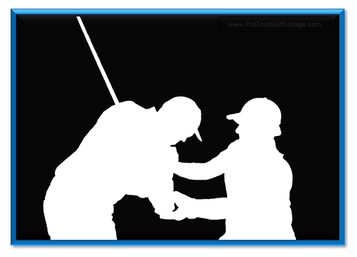 One of the biggest and most consistent challenges you will face becoming an advanced level golfer is to continually find ways to improve your game. This is easier said than done because you have to keep a steady focus - not just on your performance on the golf course, but also the work you’re performing on the practice fairway. If your scoring average is 80, or better, then it’s fair to say that you are an advanced golfer, and if you haven’t worked it out already you soon will; golf gets a lot tougher as your golf score average gets lower. This as I mentioned is a challenge that requires much more than just taking golf lessons to improve your golf swing technique. Golf swing lessons are very helpful for higher handicap golfers who will definitely see benefits in taking lessons from a competent golf instructor. Here’s the problem; if you have designs on becoming a top level amateur or professional golfer you need to find a golf instructor who has specialized knowledge and lots of experience working with advanced amateur golfers, and a successful track record taking his students to much higher levels of achievement. My partner at Pro Tour Golf College David Milne (pictured below) has coached two of his students to number one amateur in the world. He coached them from junior golfers all the way through to the pro tours and has consistently been able to get the most out of his students in terms of continually improving their golf score average for well over 20 years.  Like the medical field has general practitioners and specialists, the golf instruction industry also has ‘G.P’s’ who give lots of lessons to average golfers (and they are usually very good at it) and specialist golf instructors who focus on, and have carved a niche working with advanced and elite level golfers. When you seek out a golf instructor for an instruction program you need to find out how long the golf instructor has been teaching professionally. If the golf instructor has been teaching professionally for less than three years you should probably keep looking as it will be helpful to find a golf instructor who has been continuously teaching all levels of golfers professionally for a period of at least five to ten years. Why? Like experts in most fields, there is an element in the success formula that arrives only after many hours of trial and error, study and experience; that results in a detailed golf lesson map with lots of choices and strategies for generating continuous improvement in their students. Specialist golf instructors offer many more options. There's an old saying in the golf teaching game that goes like this; "a good teacher has a method, but a great teacher has many". If the golf instructor works at a driving range and rarely if ever teaches short-game skills and golf course skills, then keep looking. If the golf instructor runs or works in a golf shop and on average does less than 10 hours of lessons per week then keep looking. If you’re investing time, effort and money and your game is not progressing steadily, then it’s time for a change. You are entitled to a return on investment and as you get to lower scores you need to realize that there’s a kind of law of diminishing returns that kicks in where it seems the more effort you put into improving your game, the less improvement you experience. It is particularly important to seek out specialist golf instructors if you have hit a wall with your game and haven’t moved the improvement dial along the scale for a while. 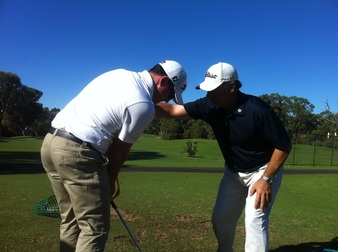 This can be an extremely frustrating time in your golf development and you might have to travel many miles to work with a specialist golf instructor to help you deal with this and other challenges, but it will be worth it. Keep in mind that if you want to become a top level golfer it will also be helpful to work with an instructor who can - or has played at a high level. This is not nearly as important for teaching average golfers, where a golf instructor who has lowered his/her handicap to single figures will be good enough to help the majority of amateur golfers. If you possess a low single digit handicap an instructor who was a top level amateur golfer or played professionally before they decided to take the path of becoming a specialist teaching professional will be very beneficial to you. The majority of PGA and LPGA trained golf instructors are golfers who have turned professional only after becoming competent amateur golfers. In fact in Australia, the UK, Canada and the US you cannot start training as a PGA golf professional until your reach a low single digit handicap. From there you become an assistant professional and you work under a senior golf professional for 2 to 3 years. If possible look for PGA instructors who have worked under well-known golf instructors because they have been continually exposed to up to date golf teaching practices, and they have usually given lots of lessons. For example, a friend of ours Jim McLean has successful golf schools around the USA and overseas and his golf instructors are very well trained because Jim sets very high standards for his golf instructors, and continually works with them on their communication and their golf teaching skills. To continually improve your golf is the biggest challenge you will face as a motivated and ambitious golfer, so it makes good sense to invest your time, effort and money working with golf instructors who can support and nurture your golf skills and help you to smash through the golf performance wall to lower scores and success playing golf. If improving your golf is important to you, then it is equally important for you to carefully choose the golf instructor with whom you work with. This will be advantageous to you in the long run working with a golf teaching specialist who can help you to live your dream of becoming a top level amateur or professional golfer. Lawrie Montague and David Milne - Pro Tour Golf College Your Success On Tour is Our Business  Golf and tendon injuries seem to go ‘hand in hand’ with golf. In fact, putting aside the lower back area, which is most commonly injured, the wrist, elbow and even shoulder area’s predominantly involve tendon pathologies. Traditionally we referred to these injuries at ‘tendinitis’; implying an inflammatory reaction in the tendon. Research lately has shown that there is in fact little or no inflammation generally in these injuries. Rather there are degenerative changes present to the collagenous tendon structure. Tendinitis has now therefore been renamed Tendinosis, to stop the association with inflammation. With this renaming, golfers must now change the way they look to manage these common injuries life golfers elbow, tennis elbow, flexor and extensor carpi ulnaris tendinosis (wrist).  Traditionally the golfer would maybe ice and take some painkillers. If this didn’t work they would move onto oral NSAIDS (nonsteroidal anti-inflammatory medications) like Ibuprofen (nurofen) or Diclofenec (voltaren) and keep playing. If over a short (or sometimes long……..) time this didn’t work, a visit to the Doctor may have resulted in a referral for a cortisone injection. Bearing in mind what we have talked about previously, that being the lack of actual inflammation in this injury, it is not surprising that recent research tends to show that this path has no long-term benefit to this type of injury. Cortisone, if repeatably used, has been shown to cause adverse effects to the tissue in the area. Pain relief is generally felt in the short term, however it is felt that this is due to it ‘blocking’ or ‘retarding’ other irritating substances that occur as part of the injury process, not actual accelerating the healing.  The approach that research does support strongly for tendinosis injuries, and that in my opinion is a necessity, is an eccentric strengthening program. An eccentric muscle action is where a muscle lengthens while contracting. A program designed with these exercise’s needs to be performed for 90+ days consistently. So you must be patient otherwise the proper repair will not occur. With a specific eccentric strengthening program being used to repair the damaged tendon the golfer must then make sure they identify the cause of this ‘over-use’ type injury. Technically your coach may identify swing factors that cause increased stress (or over-use) to the tendon. A full golf specific screening by your physiotherapist may also identify other impaired (weak, tight etc.) area’s that need to be addressed As with any injury you always need to seek appropriate advice and if in doubt discuss the most appropriate management option. Martin McInnes - GolfFit Physiotherapy |
Archives
June 2019
|
Proudly Supported By
Copyright © 2011 - 2018 Pro Tour Golf College
Website Managed By Golf Performance Media
All Rights Reserved
Website Managed By Golf Performance Media
All Rights Reserved


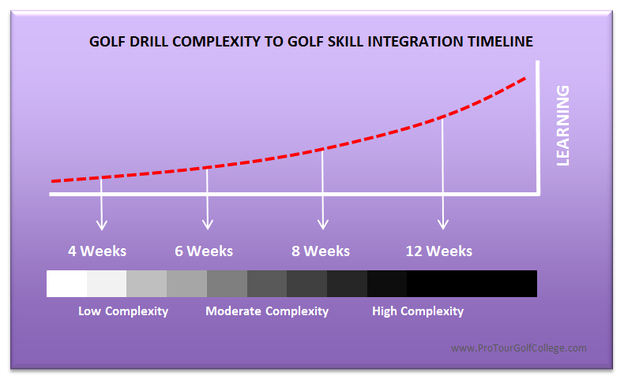








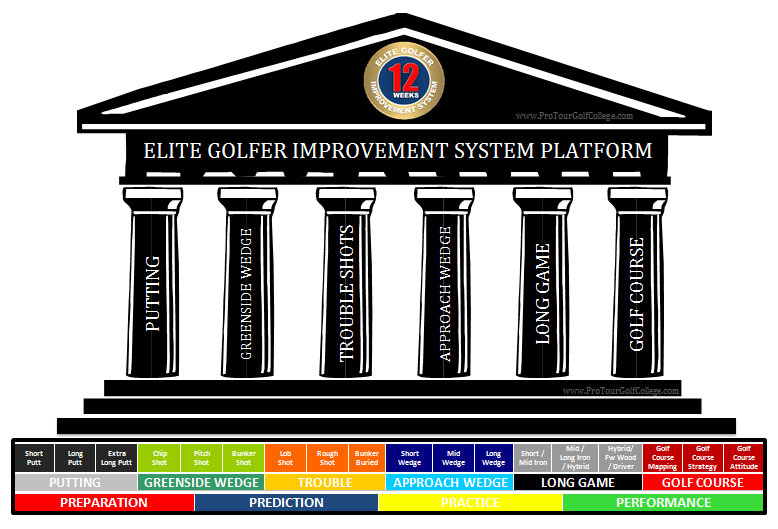







 RSS Feed
RSS Feed



